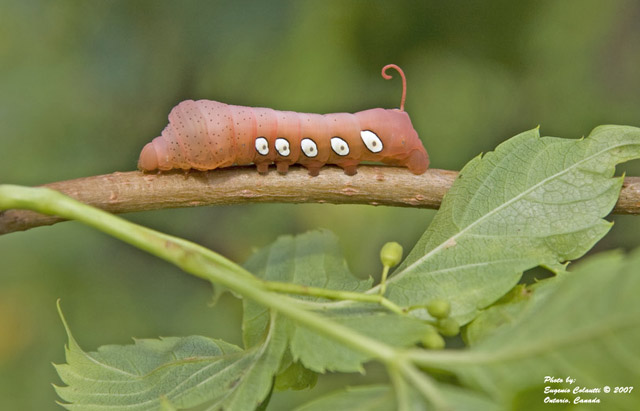Eumorpha pandorus
Pandorus Sphinx, Eumorpha pandorus, third instar, August 27, 2007,
Marmora, Ontario, courtesy of Eugenio Colautti.

Pandorus Sphinx, Eumorpha pandorus, third instar, August 27, 2007,
Marmora, Ontario, courtesy of Eugenio Colautti.
"In searching the internet for this I did not find this color or this curved horn on a Eumorpha pandorus.
"You are welcome to use the photo if you wish.
"Photo taken in Marmora, Ontario."
I wrote back and explained that the horn is not present in the final instar. I am pretty sure the image Eugenio sent is of a third instar larva.
When the Eumorpha pandorus caterpillars first hatch from almost globular dark green eggs (yellow somewhat just before hatching), the anal horn is dark and as long as the body, ending in two setae. At its base is a red brown patch extending part way onto the anal shield.
Egg incubation can be as few as six days, and eggs are deposited singly. The hatchling larvae have large pale green heads and yellow green bodies, feet and legs.
Larvae can shed skins and move into an identical looking second instar, except the heads are now in better proportion to the body (i.e., don't seem so large) and yellowish-white subdorsal lines and tiny dots.
In warm conditions larvae can molt again in as few as three or four days. The five cream coloured, obliquely oval patches, diagnostic of E. pandorus appear in the third instar. There is also a visible dark dorsal line and the appearance of small black spots on thoracic segments, becoming less numerous on the abdominal segments. The horn is still long in this stage, usually red, and curled forward over the back.
Molting into fourth instar can occur in three to four days. Many larvae now have orange to pinkish-brown to brown skins in the fourth instar. The anal horn is now greatly reduced, but still present. Just forward of the horn is a small yellow tubercle with a black circle and centered black dot, marking the spot for the eye, sans horn, of the fith instar.
It is in the fifth instar that most people encouter E. pandorus larvae. They are voracious eaters, usually for up to another week, having spent four to five days in fourth instar stage. In the fifth instar thay can be green to almost black, usualy with five obliquely oval patches, sometimes four. There is no longer any anal horn.
Under normal conditions, mature larvae leave foliage and excavate subterranean chambers in which to pupate. They will pupate, however, in five to six days in plastic tubs or buckets without soil.
If you carefully examine grape, Virginia creeper or woodbine foliage in New England or southern Canada in August-October, you have a good chance of finding E. pandorus larvae.
Use your browser "Back" button to return to the previous page.